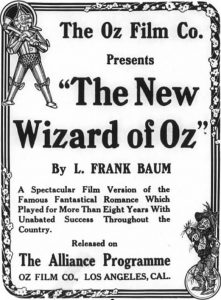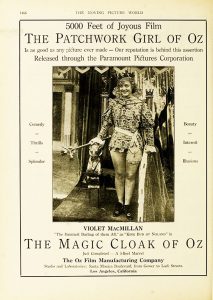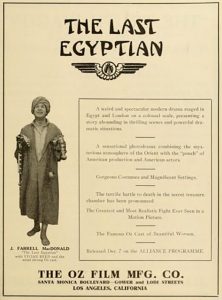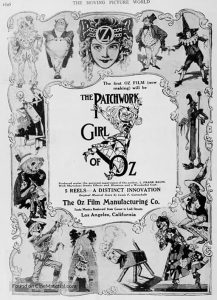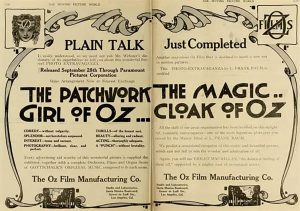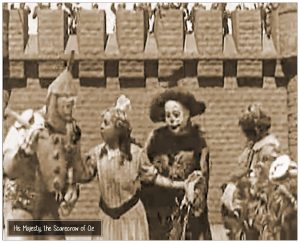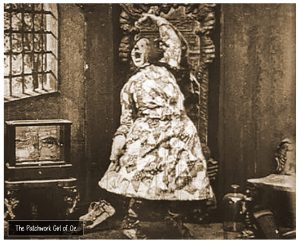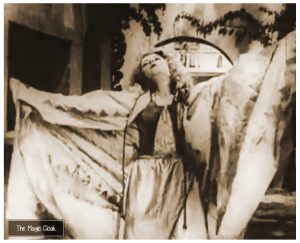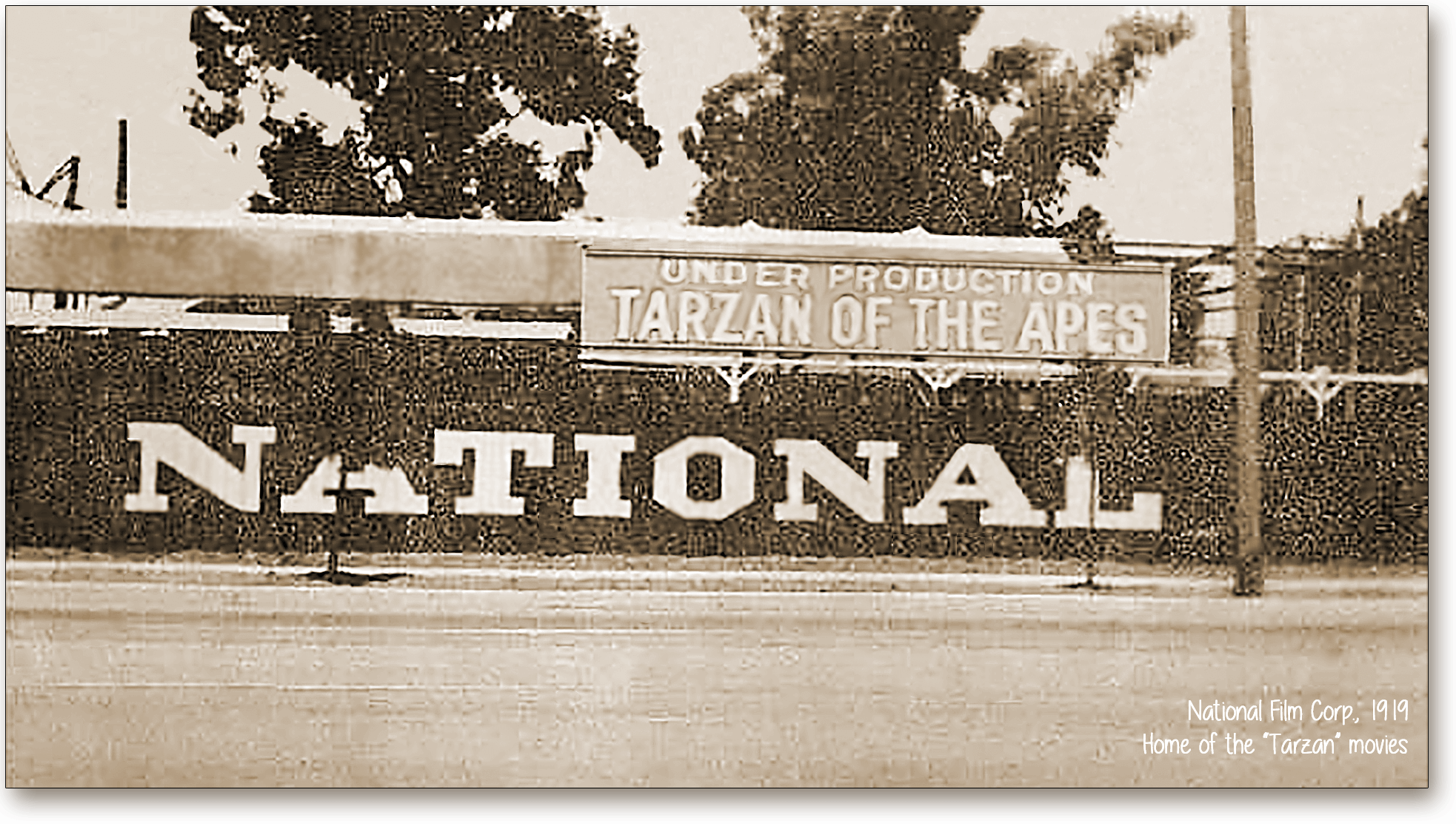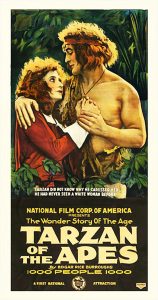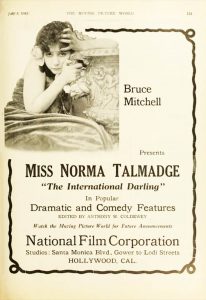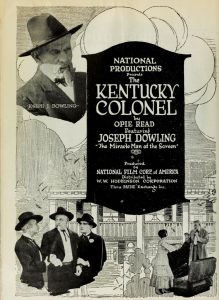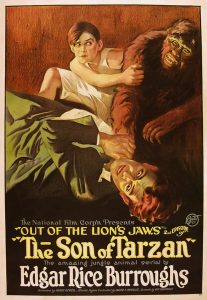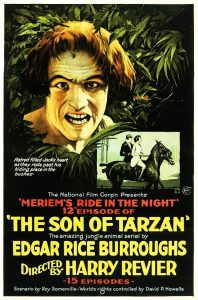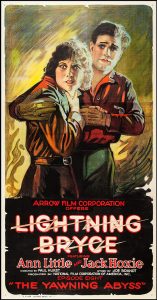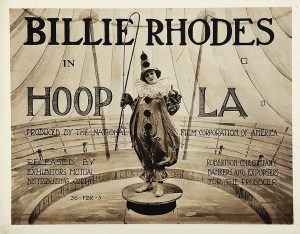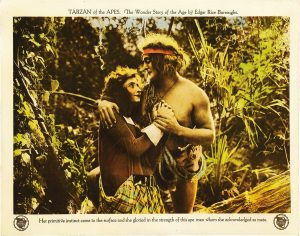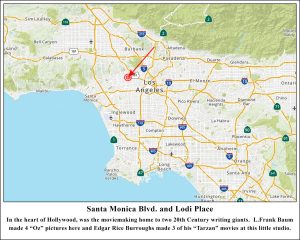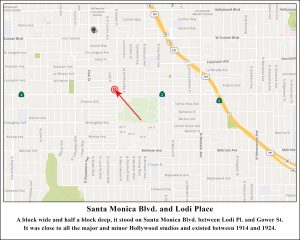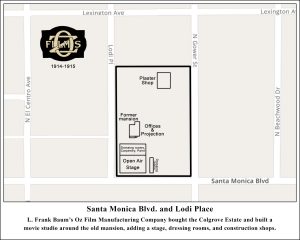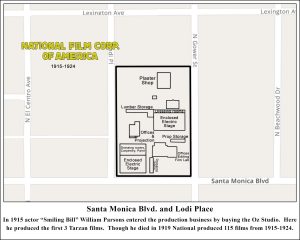Santa Monica Blvd. at Lodi Place
Oz Film Mfg. Co. and National Film Corp.
In the heart of Hollywood, this little studio faced Santa Monica Blvd. between Lodi Place and Gower Avenue.
It is where L. Frank Baum made several Oz movies and Edgar Rice Burroughs' first "Tarzan" movies were made.
Related Pages:
The stage itself had the usual diffusers above, to make direct light more subtle, but diffusers were installed along the sides of the stage as well for better light control. A large trap door was built into the floor to help in the making of Baum's fairy tales. A plaster shop was built at the rear of the studio grounds for the construction of papier-mâché sets props and set pieces.
Old pepper, pine, and eucalyptus trees adorned the grounds.
Though he never made a version of The Wonderful Wizard of Oz at here at his own studio (he had sold the rights to several of his works to pay outstanding debts), Mr. Baum produced five movies here during its one year of existence, including three Oz movies. The first was The Patchwork Girl of Oz followed by The Magic Cloak of Oz (released as The Magic Cloak)and then His Majesty, the Scarecrow of Oz (later renamed The New Wizard of Oz). All three of these films are still in existence, as well as Selig's original The Wonderful Wizard of Oz.
The studio, and L.Frank Baum's involvement in the movie business ended in 1915.
Baum wrote 14 Oz stories, another 41 novels, 83 short stories, over 200 poems. He penned 42 scripts. On May 5, 1919, Baum suffered a stroke and went into a coma. He died the following day, May 6, 1919. His final novel, Glinda of Oz, was published a year later.

Oz Studio
1116 Lodi Pl.
1914-1915
L. Frank Baum wrote a series of 14 books that today are regarded as treasures. Collectively they are known as "The Wizard of Oz."
Lyman Frank Baum was born on May 15, 1856 in Chittenango, New York. His father was a well-to-do businessman, so Baum lacked for nothing. Baum was a sickly child. He was homeschooled, which left him with time for daydreaming and developing his writing skills. As a youngster, his father gave him a printing press and Lyman, as he was known as a child, created his own newspapers, beginning his prolific writing career.
In 1880, Baum's father built him a theater where he wrote, produced, and directed his own stage productions. He also acted from time to time, and recruited friends and family to act in his productions. He had a modicum of success, and further honed both his business and writing skills, which would serve him well later.
In 1900 Baum published his greatest work, The Wonderful Wizard of Oz. It was the best selling children's book for two years and spawned another 13 books about the land of Oz. In 1902 it was turned into a stage musical under the name The Wizard of Oz, the first time the shortened name was used. In 1910, Baum's first book, "The Wonderful Wizard of Oz," was put on film by Selig Polyscope Company over in Edendale. Selig also made The Land of Oz, Dorothy and the Scarecrow in Oz, and John Dough and the Cherub (based on a non-Oz Baum novel) at his Edendale Studio. Only The Wonderful Wizard of Oz survives.
It took another 4 years and the building of his own studio for L. Frank Baum to get more of his books onto the screen. This all took place well before the well-know Judy Garland version in 1939, and a decade before the second version starring Oliver Hardy as the Tin Woodman was filmed in 1925.
The Oz Film Manufacturing Company was started by Baum and a group of friends. Baum was the company President, even though he actually invested none of his own money. His contribution to the company was his Oz stories. Louis F. Gottschalk was company Vice President, Harry Marston Haldeman was secretary, and Clarence R. Rundel was treasurer. The company saw its mandate as producing family-oriented fantasies to counter the violent Cowboy and Indian movies children were seeing at the theaters.
Constructed in 1914, The Oz Studio was one block long and half a block deep. It was originally the estate of U.S. Senator Cornelius Cole, who owned one of the original Spanish land grants, an area he named Colegrove. Today we know as Hollywood.
The Cole mansion's drawing-room was turned into a projection room and darkroom. The dining room was converted into Oz Company offices. The rest of the house was used for various parts of the movie-making process. Outside, a 65-foot by 100-foot stage was built in the southwest corner of the lot. A two-story building was erected behind the stage. A prop room, scene docks, paint frames, and a carpentry shop were on the ground floor of the new building, and on the upper floor were the stars' dressing rooms overlooking the stage. The dressing rooms were outfitted with hot and cold running water (something we take for granted today but was a unique feature in 1914) and in between the ten second floor dressing rooms, were restrooms and showers. Additional dressing rooms were adjacent to the stage for the minor players and extras.
Oz Film Co. Founders
From left: Charles Rundel, L.Frank Baum, H.M Halderman, and Louis F. Gottschalk
Photo courtesy of Marc Wanamaker / Bison Archives click to enlarge
Screen shots of the Oz films made here
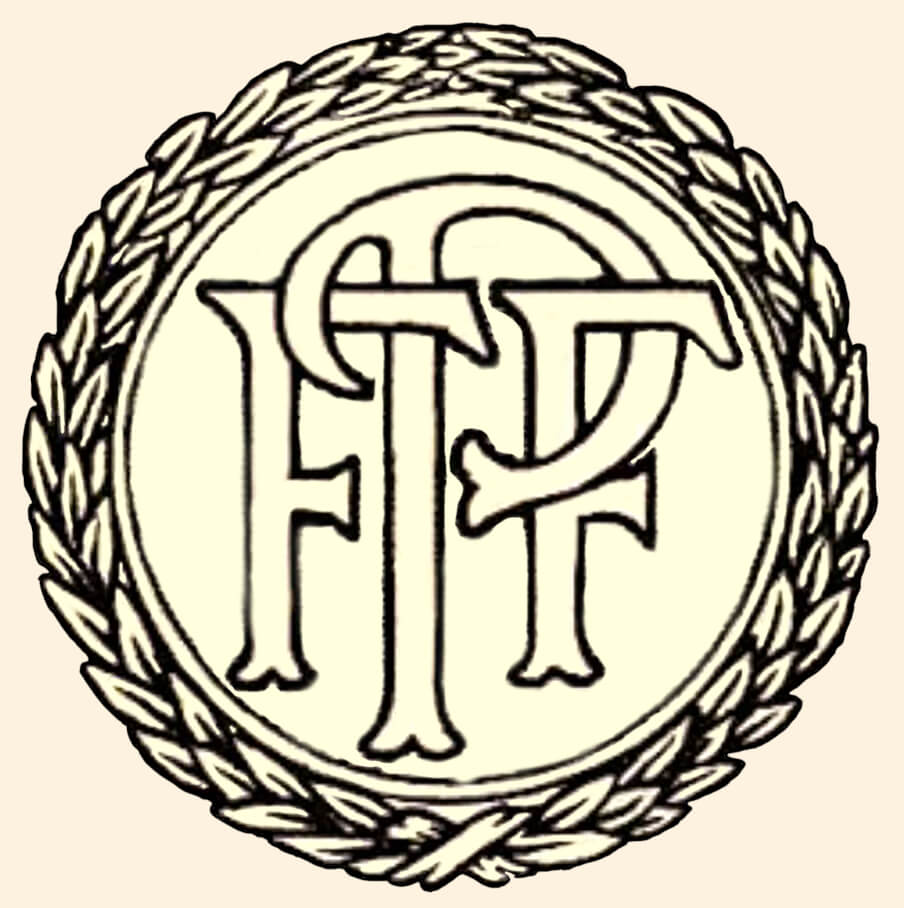
Famous Players Film Co.
1116 Lodi Pl.
1915-1915
Adolph Zukor is best remembered as the driving force behind Paramount Pictures. In his day, perhaps the most powerful person in the movie business. In early 1914 he made a decision to move his base of operations from New York to Los Angeles. He found a little studio to buy at the corner of Melrose and Bronson and put his studio manager, Al Kaufman, in charge of building out the new studio. Meanwhile, to get production started, he rented out the Oz Studio in December, 1914, when L. Frank Baum left the studio. Zukor's production head, Allan Dwan, took the company there and started to make movies. They moved out in April 1915 when their Melrose Ave. studio was ready for filmmaking.
Photo courtesy of Marc Wanamaker / Bison Archives click to enlarge
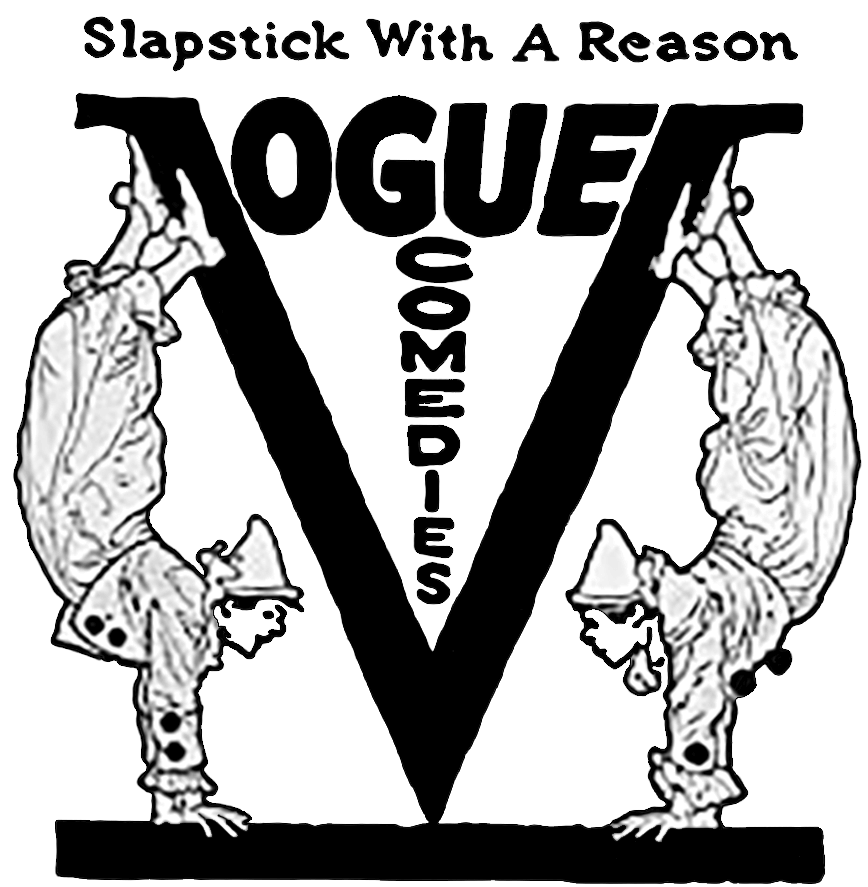
Vogue Film Co.
1116 Lodi Pl.
1916-1917
Vogue Film Co. (producing Vogue Comedies) was a short-lived production company. It was formed by Samual Hutchinson who was an early mogul and also one of the owners of the American Film Company of Chicago/Santa Barbara, the Mutual Company, a film distributor, Signal Film Co., and Lone Star. He had his hands in many movie pies.
Vogue, it appears, was a tenant of the lot during the period when National Film Company owned the studio. They shared the studio.
Vogue's major star was Ben Turpin, who, after a minor career in Vaudeville, got his start when he was a janitor and carpenter for the Essanay Film Company of Chicago. He was "discovered" ad given minor roles but eventually gained fame was as Charles Chaplin's foil during his time at Essanay. Turpin bolted from Essanay, anticipating their decline as they fell apart after Chaplin left the company. Later Turpin would even gain more fame as one of Mack Sennett's comedy stars. In between his Essanay and Sennett stints he worked for Vogue.
You will recognize Turpin by his small wiry frame, a brush mustache, and crossed eyes, which legend has it he had insured by Lloyd's of London for a one hundred thousand dollars, in case they ever straightened out.
Vogue only lasted two years but produced just one hundred films during that time, many starring Turpin. They were out of business by 1917.

National Film Studio
1116 Lodi Pl.
1915-1924
Overweight, balding comedic actor "Smiling Bill" William Parsons got his start in pictures as an actor for the Vitagraph company, but in 1915 he made the decision to go into the production side of the business. Along with 5 partners and an investment of $100,000, he bought the nearly new Oz Studio at Santa Monica and Lodi and renamed it National Film Corp. of America. With production veteran Isidore Bernstein at his side, they put Norma and Constance Talmadge under contract. Their first picture was The Tale of the Night Before starring himself. He made many movies starring him and his wife Billie Rhodes.
Parsons's big claim to fame was the production of the first of Edgar Rice Burrough's famous Tarzan movies, Tarzan of the Apes in 1918 starring little known actor Elmo Lincoln. He followed up with two more Tarzan movies, The Son of Tarzan and The Adventures of Tarzan. The Tarzan films made National Film a well-known and profitable company, and Elmo Lincoln a famous and wealthy actor.
Smiling Bill died in 1919 from his Diabetic condition. But the company he started lasted until 1924. National produced 115 films between 1915 and 1924. Many of them very successful, starring Hollywoods best actors and actresses. The studio no longer exists.





